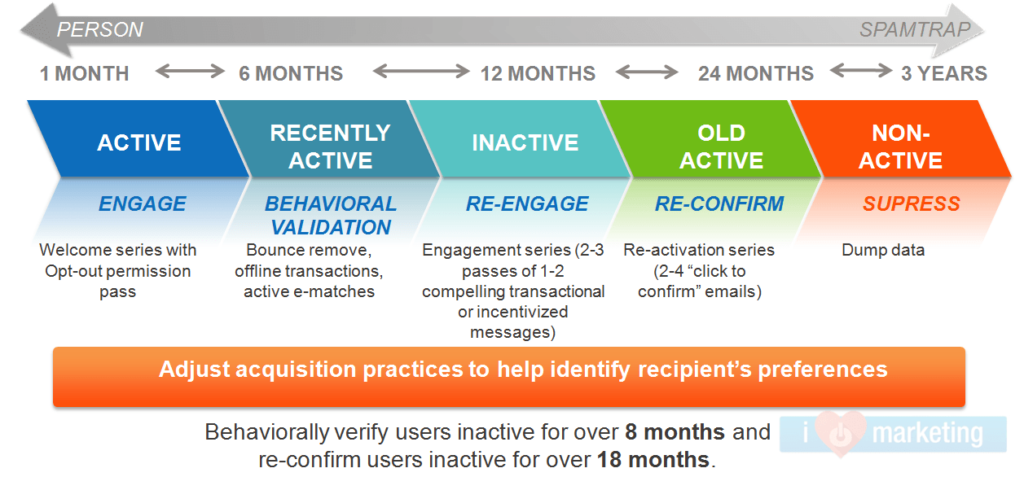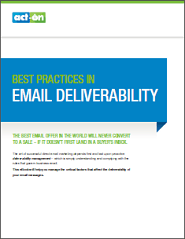As we’ve written about before, deliverability is personal. Individual interaction with an email will  determine where it will end up: the inbox or the junk folder or whether it will reach your recipient’s mailbox at all.
determine where it will end up: the inbox or the junk folder or whether it will reach your recipient’s mailbox at all.
It’s known now that ISPs and email providers value engagement above all else when filtering mail to their subscribers’ inboxes so, as marketers, we should focus more and more energy on personalizing email to the individual receiving it – not to a demographic.
The importance of knowing when to let go of an unengaged email subscriber is growing, and here in the Act-On deliverability team, we’ve had many questions about the best strategy for pruning marketing lists of this dead weight.
As a counter-argument, some marketers argue that growing lists and hitting as many inboxes as possible will keep you top-of-mind, and there is some old marketing wisdom in that. But: say you send 1,000 emails and of those you average 100 opens. Your engagement is 10%. Then say you trimmed 25% of that list, removing emails that had not interacted with your emails for 6 months. Now your engagement score is about 13%. That’s if you have the same 100 opens. But your engagement score has gone up and email providers are more likely to pass more of your emails on to more inboxes. It’s counter-intuitive, but you’ve actually reached more people – by emailing fewer of them.
So how do you achieve that? What’s the best way to clean your lists of unengaged recipients? There’s no one solution that will fit all. But, apply some analysis and strategy, and a little trial and error, and you can get there. At a high level, there are two questions that need to be answered:
- Who are your unengaged subscribers?
- What’s the best way to go about removing them from your marketing list?
By asking these and answering them as completely as possible, you can develop a strategy that fits your business, your marketing models, and your customers.
Factors that indicate unengaged subscribers
You’ll have to consider your type of business and your email marketing strategy first.
- Think about your customer’s buying cycle and how often they buy, and how often you should email them.
- Consider the size of your lists and the risk your unengaged recipients signify. A larger list will not feel the effects of a few inactives as much as a smaller list might, so smaller lists should be maintained even more meticulously.
- Look at your deliverability metrics often and gauge at which point, on average, recipients become unengaged. Often you’ll hear or read about a 12-month rule of thumb, but that’s a rough general guide. Some other period of time might be the right one for you to segment a list by.
How to build a re-engagement strategy
Once you’ve found a formula that works for you and you’ve got that list of unengaged email subscribers, you’ll need a re-engagement campaign strategy.
Again, you’ll have to find what works best for your company and customers. Will you simply remove inactives from your mailing lists? Or do you risk emailing them and attempting a re-engagement campaign? If you decide to try to re-engage, what will these emails look like?

You can get really creative here and put your best foot forward. (And you don’t have much – if anything – to lose.)
- Try being as personal as possible: the customer is more likely to engage if they feel they have a relationship with your company.
- Did they ever buy anything? Remind them. Do a product satisfaction survey, or let them know that thing they bought is being closed out, so this is their last chance to buy again.
- Give them a specific call to action to prove they want to continue hearing from you. If they’ll take that action, you know this is a more valuable contact than someone who simply opened the email.
- Consider asking them to renew their opt-in.
You’ll need to think of how many emails to send inactives before removing them, as well. As an example, Google’s marketing team follows a schedule: they gradually decrease frequency to their inactives and eventually ask them whether they want to continue receiving emails from them. If there is still no response, Google feels it is safe to say their emails are unwanted and they remove the addresses from their lists. The length of your re-engagement campaign really depends on your email frequency so if you email your lists more regularly, you’ll have more options.
No one wants to part with potential customers … but you should be willing to part with those people who will never buy, even if they did accidentally open your email last year. Those are the people who clog your lists and drag down your deliverability. Setting them free will both lighten your load and raise your batting average.
List maintenance and health is integral to your good deliverability. ISPs will reward you for taking the time to maintain a pristine list and for following best practices. You’ll quickly see the value of purging your lists on inactive users and find the more you stick to this routine, the fewer unengaged subscribers you’ll have to strip from your campaigns.
time to maintain a pristine list and for following best practices. You’ll quickly see the value of purging your lists on inactive users and find the more you stick to this routine, the fewer unengaged subscribers you’ll have to strip from your campaigns.
In addition to list maintenance, the art of successful email marketing depends heavily upon deliverability management. For more tips and tricks on how to improve your deliverability, take a look at our eBook, Best Practices in Email Deliverability and learn how to manage the critical factors that affect the deliverability of your email messages.
